VII Python(9)socket编程
socket编程:
网络基础;
TCP/IP;
socket模型;
python socket C/S开发;
非阻塞(select、poll、epoll)
网络基础:
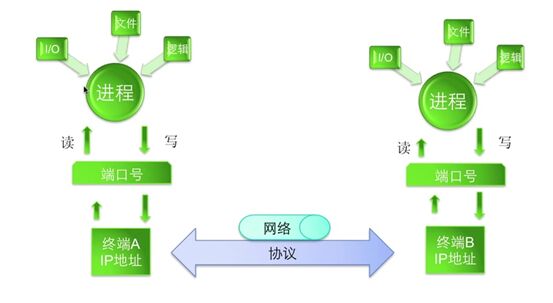
OSI七层协议、TCP/IP分层
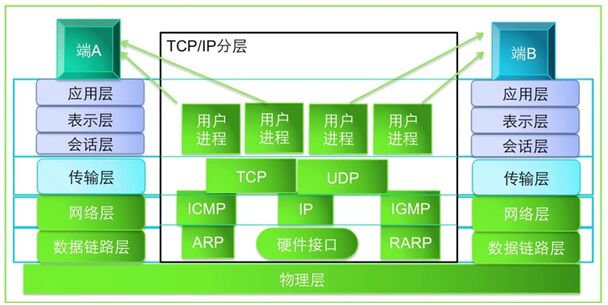
注:
物理层(数据之间比特流的传输、物理接口、电气特性;硬件接口标准,如RJ45水晶头、无线网络传输802.11b等);
数据链路层(组帧,进行硬件地址寻址,差错校验等功能;ARP、RARP;单个链路上数据的传输,如传输依赖的是光纤、双绞线、还是无线等方式);
网络层(进行逻辑地址寻址,实现不同网络之间的路由选择;ICMP、IP、IGMP;定义了端到端包的封装方式,分片传输,如物理层的传输媒介传输单元的大小控制(通常网卡属性上有单元大小,一般默认是1460长度一个单位),还定义了网络中节点的逻辑位置(逻辑坐标));
传输层(可靠与不可靠传输,传输前的错误检测、流控;TCP、UDP;网络中数据的传输和控制,如tcp有连接状态,保证数据传输无差错,udp无连状态,终端A只发送不管终端B是否收到,负责处理整个数据流拆成多个包时组装次序的过程);
会话层(建立、管理、中止会话;决定了如何控制开始和结束的端对端的会话);
表示层(数据的表示、安全、压缩;定义传输的数据格式,ASCII还是binary方式);
应用层(用户接口;计算机中通信的具体应用,如Email、httpd等);
TCP三次握手、四次挥手:
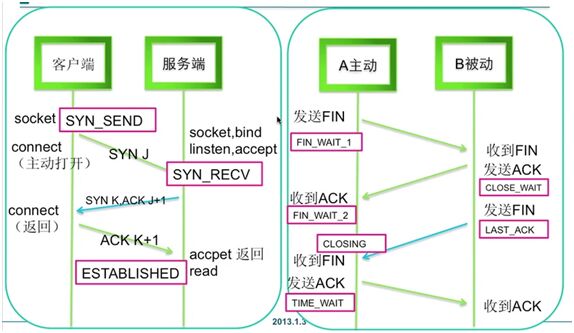
TCP finite statemachine(FSM):
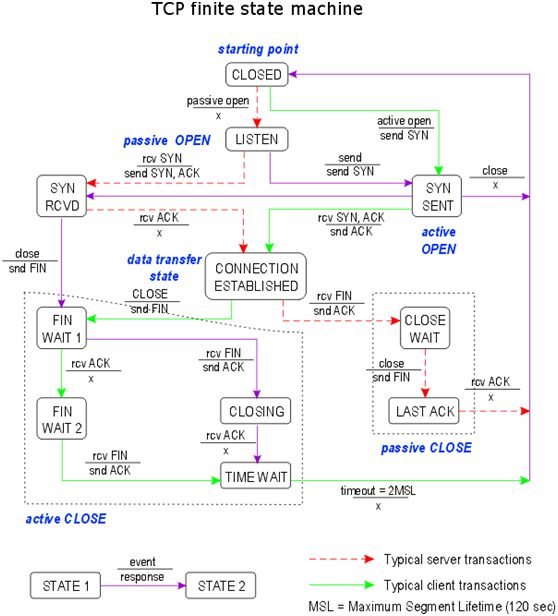
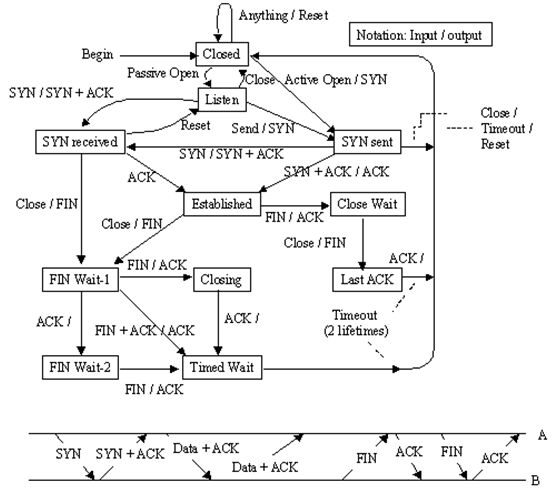
注:
CLOSED(there is no connection);
LISTEN(passive openreceived;waiting for SYN);
SYN-SENT(SYN sent;waiting forACK);
SYN-RCVD(SYN+ACK sent;waiting forACK);
ESTABLISHED(connectionestablished;data transfer in progress);
FIN-WAIT1(first FIN sent;waiting forACK);
FIN-WAIT2(ACK to first FINreceived;waiting for second FIN);
CLOSE-WAIT(first FIN received,ACK sent;waiting forapplication to close);
TIME-WAIT(second FIN received,ACK sent;waiting for2MSL(maximum segment lifetime,120s) timeout);
LAST-ACK(seconf FIN sent;waiting forACK);
CLOSING(both sides havedecided to close simultaneously)
socket C/S模式网络开发:
网络中不同主机间进程的交互;
client connect() 连接server-side时会随机用一个port号;
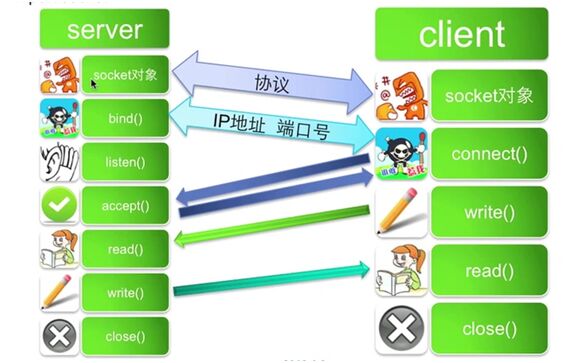
socket套接字,用于描述IP:PORT,是一个通信链的句柄handler,应用程序通常通过socket向网络发出请求或者应答网络请求;socket起源于Unix,而Unix/Linux基本哲学之一是“一切皆文件”,对于文件用“打开、读写、关闭”模式来操作,socket就是该模式的一个体现,即是一种特殊的文件,一些socket函数就是对其进行的“r/wIO、打开、关闭”);
socket和file的区别(file是针对某个指定的文件进行“打开、读写、关闭”;而socket是针对server-side和client-side进行“打开、读写、关闭”);
sock=socket.socket(socket.AF_INET,socket.SOCK_STREAM) #(创建对象)
参数一,地址簇:
AF_INET为ipv4地址;
AF_INET6为ipv6地址;
AF_UNIX只能用于单一的Unix系统连接;
参数二,类型:
SOCK_STREAM指tcp协议默认;
SOCK_DGRAM指udp;
SOCK_RAW原始套接字,普通的套接字无法处理ICMP、IGMP等网络报文,而SOCK_RAW可以,而且SOCK_RAW也可处理特殊的IPv4报文,另利用原始套接字,可通过IP_HDRINCL套接字选项由用户构造IP头;
参数三,协议:
0(默认,与特定的家族相关的协议,若是0系统会根据地址格式和套接类别自动选择一个合适的协议);
sock.setblocking(bool) #(是否blocking,默认为True,如果设置False那accept和recv时一旦无数据则会报错)
sock.setsockopt(level,option,value) #(设置套接字选项,level是被设置的选项的级别,若要想在套接字上设置level必须为SOL_SOCKET,在此级别下option有众多选项其中SO_REUSEADDR表示打开或关闭地址利用功能,value为0表示关闭,非0打开;SO_DEBUG表示打开或关闭调试信息;SO_DONTROUTE表示打开或关闭路由查找功能;SO_BROADCAST表示允许或禁止发送广播数据;SO_SNDBUF设置发送缓冲区的大小,有上下限,下限为2048byte,上限为256*(size of (struct sk_buff)+256))
sock.bind(address) #(将套接字绑定到地址,address的格式取决于地址族,在AF_INET下,以tuple的形式表示地址(IP,port))
sock.listen(backlog) #(开始监听传入连接,backlog指定在拒绝连接之前可以挂起的最大连接数量,backlog若为5表示内核已经接到了连接请求,但服务器还没有调用accept进行处理的连接个数最大为5,这个值不能无限大,因为要在内核中维护连接队列)
sock.accept() #(接受连接并返回(conn,address),其中conn是新的套接字对象,可以用来接收和发送数据,address是连接client的地址,接收tcp client的连接以blocking阻塞式等待连接的到来)
sock.recv(bufsize[,flag]) #(接收套接字的数据,数据以字符串形式返回,bufsize指定最多可以接收的数量,flag提供有关消息的其它信息,通常可忽略)
sock.recvfrom(bufsize[,flag]) #(与sock.recv(bufsize[,flag])类似,不过另有返回值(data,address),data是包含接收数据的字符串,address是发送数据的套接字地址)
sock.send(string[,flag]) #(将数据string发送到连接的套接字,返回值是要发送的字节数量,该数量可能小于string的字节大小即可能未将指定内容全部发送)
sock.sendall(string[,flag]) #(将数据string发送到连接的套接字,但在返回之前会尝试发送所有数据,成功返回None,失败则会抛出异常)
sock.sendto(string[,flag],address) #(将数据string发送到套接字,address的形式是(ip,port)的tuple,指定远程地址,返回值是发送的字节数,该函数主要用于udp协议)
sock.close() #(关闭套接字)
sock.connect(address) #(连接到address处的套接字,一般address的格式为tuple,(IP orhostname,port),如果连接出错,返回socket.error错误)
sock.connect_ex(address) #(与sock.connect(address)功能相同,只不过多了返回值,连接成功时返回0,连接失败时返回非0编码,例如10061)
sock.settimeout(timeout) #(设置套接字操作的超时期timeout是一个浮点数,单位秒,值为None表示没有超时期,一般超时期应在刚创建套接字时设置,因为它们可能用于连接的操作,例如client连接时最多等待5s)
sock.getpeername() #(返回连接套接字的远程地址,返回值通常是tuple(ip,port))
sock.getsockname() #(返回套接字自己的地址,通常是tuple(ip,port))
sock.fileno() #(套接字的文件描述符fd)
socket高级应用,IO多路复用(指通过一种机制可以监视多个描述符,一旦某个描述符就绪(一般是读就绪或写就绪),能够通知程序进行相应的读写操作);Linux中的select、poll、epoll都是IO多路复用的机制):
select(通过select()系统调用来监视多个文件描述符的数组,当select返回后,该数组中就绪的文件描述符便会被内核修改标志位,使得进程可以获得这些文件描述符从而进行后续的读写操作;此策略的缺点,单个进程能够监视的文件描述符的数量存在最大限制,Linux默认为1024,随着文件描述符数量的增大,其复制的开销也线性增长);
poll(与select类似,但没有文件描述符的限制);
epoll(内核直接支持,基于事件驱动event-driven(分两部分:注册事件和触发事件);
Python中有select模块,该模块提供了select、poll、epoll这三种方法)
rs,ws,xs=select.select(rlist,wlist,xlist[,timeout]) #(select方法用来监视文件句柄,如果句柄发生变化,则获取该句柄;括号中前三个参数必须,返回三个列表)
当rlist中的句柄发生可读时(accept和read),则获取发生变化的句柄并添加到rs中;
当wlist中含有句柄时,则将该序列中所有的句柄添加到ws中;
当xlist中的句柄发生错误时,则将该发生错误的句柄添加到xs中;
当timeout未设置select会一直blocking,直到监听的句柄发生变化;当timeout为1时,如果监听的句柄无任何变化则select会阻塞1s之后返回三个空列表,如果监听的句柄有变化则直接执行;
In [1]: import socket
In [2]: help(socket)
Functions:
socket() -- create a new socket object
socketpair() -- create a pair of new socket objects [*]
fromfd() -- create a socket object from an open file descriptor [*]
gethostname() -- return the current hostname
gethostbyname() -- map a hostname to its IP number
gethostbyaddr() -- map an IP number or hostname to DNS info
getservbyname() -- map a service name and a protocol name to a portnumber
getprotobyname() -- map a protocol name (e.g. 'tcp') to a number
ntohs(), ntohl() -- convert 16, 32 bit int from network to host byteorder
htons(), htonl() -- convert 16, 32 bit int from host to network byteorder
inet_aton() -- convert IP addr string (123.45.67.89) to 32-bit packedformat
inet_ntoa() -- convert 32-bit packed format IP to string (123.45.67.89)
ssl() -- secure socket layer support (only available if configured)
socket.getdefaulttimeout() -- get the default timeout value
socket.setdefaulttimeout() -- set the default timeout value
create_connection() -- connects to an address, with an optional timeoutand
optional sourceaddress.
In [3]: print dir(socket)
['AF_APPLETALK', 'AF_ASH', 'AF_ATMPVC','AF_ATMSVC', 'AF_AX25', 'AF_BRIDGE', 'AF_DECnet', 'AF_ECONET', 'AF_INET', 'AF_INET6','AF_IPX',……'PACKET_OUTGOING', 'PF_PACKET', 'RAND_add', 'RAND_egd','RAND_status', 'SHUT_RD', 'SHUT_RDWR', 'SHUT_WR', 'SOCK_DGRAM','SOCK_RAW', 'SOCK_RDM', 'SOCK_SEQPACKET', 'SOCK_STREAM','SOL_IP', 'SOL_SOCKET', 'SOL_TCP', 'SOL_TIPC', 'SOL_UDP', 'SOMAXCONN', ……'create_connection','errno', 'error', 'fromfd', 'gaierror', 'getaddrinfo', 'getdefaulttimeout','getfqdn', 'gethostbyaddr', 'gethostbyname', 'gethostbyname_ex', 'gethostname','getnameinfo', 'getprotobyname', 'getservbyname', 'getservbyport', 'has_ipv6','herror', 'htonl', 'htons', 'inet_aton', 'inet_ntoa', 'inet_ntop', 'inet_pton','m', 'meth', 'ntohl', 'ntohs', 'os', 'p', 'partial', 'setdefaulttimeout', 'socket', 'socketpair', 'ssl', 'sslerror', 'sys','timeout', 'warnings']
In [4]: sock=socket.socket(socket.AF_INET,socket.SOCK_STREAM) #(创建对象;参数一地址簇:AF_INET为ipv4地址,AF_INET6为ipv6地址,AF_UNIX只能用于单一的Unix系统连接;参数二类型:SOCK_STREAM指tcp协议默认,SOCK_DGRAM指udp)
In [5]: print dir(sock)
['__class__', '__delattr__', '__doc__','__format__', '__getattribute__', '__hash__', '__init__', '__module__','__new__', '__reduce__', '__reduce_ex__', '__repr__', '__setattr__','__sizeof__', '__slots__', '__str__', '__subclasshook__', '__weakref__','_sock', 'accept', 'bind', 'close', 'connect', 'connect_ex','dup', 'family', 'fileno', 'getpeername', 'getsockname', 'getsockopt','gettimeout', 'listen', 'makefile', 'proto', 'recv', 'recv_into', 'recvfrom', 'recvfrom_into', 'send', 'sendall', 'sendto', 'setblocking','setsockopt', 'settimeout', 'shutdown', 'type']
In [6]: help(sock.bind) #(server-side使用,对象绑定)
bind(...) method of socket._socketobjectinstance
bind(address)
Bind the socket to a local address. For IP sockets, the address is a
pair (host, port); the host must refer to the local host. For raw packet
sockets the address is a tuple (ifname, proto [,pkttype [,hatype]])
In [7]: help(sock.listen) #(server-side使用,指定监听多少个请求)
listen(...) method of socket._socketobjectinstance
listen(backlog)
Enable a server to accept connections. The backlog argument must be at
least 0 (if it is lower, it is set to 0); it specifies the number of
unaccepted connections that the system will allow before refusing new
connections.
In [8]: help(sock.accept) #(server-side使用,sock.accpet()返回两个参数,一个是建立连接的socket object和另一个是地址信息)
accept(self) method of socket._socketobjectinstance
accept() -> (socket object, address info)
Wait for an incoming connection. Return a new socket representing the
connection, and the address of the client. For IP sockets, the address
info is a pair (hostaddr, port).
In [9]:help(sock.recv) #(设置读操作缓冲区大小,server-side和client-side都可使用,注意server-side使用时此项要在socket.accept()返回的那个socketobject上使用)
recv(...)
recv(buffersize[, flags]) -> data
Receive up to buffersize bytes from the socket. For the optional flags
argument, see the Unix manual. When no data is available, block until
at least one byte is available or until the remote end is closed. When
the remote end is closed and all data is read, return the empty string.
In [10]:help(sock.send) #(写操作,server-side和client-side均可使用,注意server-side使用时要在socket.accept()返回的那个socketobject上使用)
send(...)
send(data[, flags]) -> count
Send a data string to the socket. For the optional flags
argument, see the Unix manual. Return the number of bytes
sent; this may be less than len(data) if the network is busy.
In [11]: help(sock.close) #(server-side和client均可使用)
close(self, _closedsocket=<class'socket._closedsocket'>, _delegate_methods=('recv', 'recvfrom', 'recv_into','recvfrom_into', 'send', 'sendto'), setattr=<built-in function setattr>)method of socket._socketobject instance
close()
Close the socket. It cannot beused after this call.
In [12]: help(sock.connect) #(用于client)
connect(...) method of socket._socketobjectinstance
connect(address)
Connect the socket to a remote address. For IP sockets, the address
is a pair (host, port).
In [13]: help(sock.getpeername) #(用于client,返回连接的服务器地址)
getpeername(...) method ofsocket._socketobject instance
getpeername() -> address info
Return the address of the remote endpoint. For IP sockets, the address
info is a pair (hostaddr, port).
In [14]: help(sock.setblocking) #(server-side用,flag为false则是non-blocking,flag为True则是blocking)
setblocking(...) method ofsocket._socketobject instance
setblocking(flag)
Set the socket to blocking (flag is true) or non-blocking (false).
setblocking(True) is equivalent to settimeout(None);
setblocking(False) is equivalent to settimeout(0.0).
In [15]: help(sock.setsockopt) #(server-side用)
setsockopt(...) method ofsocket._socketobject instance
setsockopt(level, option, value)
Set a socket option. See the Unixmanual for level and option.
The value argument can either be an integer or a string.
In [16]: import select
In [17]: print dir(select)
['EPOLLERR', 'EPOLLET', 'EPOLLHUP','EPOLLIN', 'EPOLLMSG', 'EPOLLONESHOT', 'EPOLLOUT', 'EPOLLPRI', 'EPOLLRDBAND','EPOLLRDNORM', 'EPOLLWRBAND', 'EPOLLWRNORM', 'PIPE_BUF', 'POLLERR', 'POLLHUP','POLLIN', 'POLLMSG', 'POLLNVAL', 'POLLOUT', 'POLLPRI', 'POLLRDBAND','POLLRDNORM', 'POLLWRBAND', 'POLLWRNORM', '__doc__', '__file__', '__name__','__package__', 'epoll', 'error', 'poll', 'select']
In [18]: help(select)
NAME
select - This module supports asynchronous I/O on multiple filedescriptors.
FUNCTIONS
poll(...)
Returns a polling object, which supports registering and
unregistering file descriptors, and then polling them for I/O events.
select(...)
select(rlist, wlist, xlist[, timeout]) -> (rlist, wlist, xlist)
Wait until one or more file descriptors are ready for some kind of I/O.
The first three arguments are sequences of file descriptors to be waitedfor:
rlist -- wait until ready for reading
wlist -- wait until ready for writing
xlist -- wait for an ``exceptional condition''
If only one kind of condition is required, pass [] for the other lists.
A file descriptor is either a socket or file object, or a small integer
gotten from a fileno() method call on one of those.
The optional 4th argument specifies a timeout in seconds; it may be
a floating point number to specify fractions of seconds. If it is absent
or None, the call will never time out.
The return value is a tuple of three lists corresponding to the firstthree
arguments; each contains the subset of the corresponding filedescriptors
that are ready.
In [19]: import Queue
In [20]: help(Queue)
NAME
Queue - A multi-producer, multi-consumer queue.
class Queue
| Create a queue object with agiven maximum size.
| get(self, block=True,timeout=None)
| Remove and return an itemfrom the queue.
| If optional args 'block' istrue and 'timeout' is None (the default),
| block if necessary until anitem is available. If 'timeout' is
| a non-negative number, itblocks at most 'timeout' seconds and raises
| the Empty exception if noitem was available within that time.
| Otherwise ('block' isfalse), return an item if one is immediately
| available, else raise theEmpty exception ('timeout' is ignored
| in that case).
| get_nowait(self)
| Remove and return an itemfrom the queue without blocking.
|
| Only get an item if one is immediatelyavailable. Otherwise
| raise the Empty exception.
| put(self, item, block=True,timeout=None)
| Put an item into the queue.
| If optional args 'block' istrue and 'timeout' is None (the default),
| block if necessary until afree slot is available. If 'timeout' is
| a non-negative number, itblocks at most 'timeout' seconds and raises
| the Full exception if nofree slot was available within that time.
| Otherwise ('block' isfalse), put an item on the queue if a free slot
| is immediately available,else raise the Full exception ('timeout'
| is ignored in that case).
| put_nowait(self, item)
| Put an item into the queuewithout blocking.
| Only enqueue the item if afree slot is immediately available.
| Otherwise raise the Fullexception.
In [21]: print dir(Queue)
['Empty', 'Full', 'LifoQueue','PriorityQueue', 'Queue', '__all__','__builtins__', '__doc__', '__file__', '__name__', '__package__', '_threading','_time', 'deque', 'heapq']
In [22]: print dir(Queue.Queue)
['__doc__', '__init__', '__module__','_get', '_init', '_put', '_qsize', 'empty', 'full', 'get','get_nowait', 'join', 'put', 'put_nowait','qsize', 'task_done']
举例-version1(使用socket模块实现C/S通信)
[root@localhost ~]# vim server_test.py
----------------script start-----------------
#!/usr/bin/python2.7
#
import socket
server=('10.96.20.113',20072)
sock=socket.socket(socket.AF_INET,socket.SOCK_STREAM)
sock.bind(server)
sock.listen(5)
conn,address=sock.accept()
print 'connect by',address
while True:
data=conn.recv(1024)
if not data: break
print data
conn.send(data)
sock.close()
--------------------script end-----------------
[root@localhost ~]# vim client_test.py
--------------------script start---------------
#!/usr/bin/python2.7
#
import socket
server=('10.96.20.113',20072)
sock=socket.socket(socket.AF_INET,socket.SOCK_STREAM)
sock.connect(server)
sock.send('hello')
data=sock.recv(1024)
print 'echo',data
sock.close()
---------------------script end------------------
[root@localhost ~]# python2.7 server_test.py #(分别在两个终端上运行server-side和client-side)
connect by ('10.96.20.113', 48273)
hello
[root@localhost ~]# python2.7 client_test.py
echo hello
举例-version2(使用socket模块实现C/S通信)
[root@localhost ~]# vim client_test.py #(服务端与version1相同,只更改client)
-------------------script start-----------------
#!/usr/bin/python2.7
#
import socket
import time
server=('10.96.20.113',20072)
msg=['hello','everyone','welcome','to','my','territory']
sock=socket.socket(socket.AF_INET,socket.SOCK_STREAM)
sock.connect(server)
for m in msg:
sock.send(m)
data=sock.recv(1024)
print 'echo',data
time.sleep(2)
sock.close
-----------------------script end-----------------
[root@localhost ~]# python2.7 server_test.py #(分别在两个窗口上运行server_test.py和client_test.py)
connect by ('10.96.20.113', 48275)
hello
everyone
welcome
to
my
territory
[root@localhost ~]# python2.7 client_test.py
echo hello
echo everyone
echo welcome
echo to
echo my
echo territory
[root@localhost ~]# python2.7 client_test.py #(再次运行client,由于server-side已不在运行,窗口已关闭,client运行时Connectionrefused拒绝连接)
Traceback (most recent call last):
File "client_test.py", line 9, in <module>
sock.connect(server)
File "/usr/local/python2.7/lib/python2.7/socket.py", line 224,in meth
return getattr(self._sock,name)(*args)
socket.error: [Errno 111] Connection refused
注:server-side不支持并发操作不能作为永久的伺服器;server-side没有读写分离(I/O输入输出分离),有分离的话会提高并发能力
举例(利用select模块实现处理多个client请求)
[root@localhost ~]# vim server_test.py
-------------------script start--------------
#!/usr/bin/python2.7
#
import socket
import select
import Queue
server=('10.96.20.113',20072)
sock=socket.socket(socket.AF_INET,socket.SOCK_STREAM)
sock.setblocking(False)
sock.setsockopt(socket.SOL_SOCKET,socket.SO_REUSEADDR,1)
sock.bind(server)
sock.listen(10)
rlists=[sock]
wlists=[]
msg_que={}
timeout=20
while rlists:
rs,ws,es=select.select(rlists,wlists,rlists,timeout)
if not (rs or ws or es):
print 'timeout...'
break
for s in rs:
if s is sock:
conn,addr=s.accept()
print 'connect by',addr
conn.setblocking(False)
rlists.append(conn)
msg_que[conn]=Queue.Queue()
else:
data=s.recv(1024)
if data:
print data
msg_que[s].put(data)
if s not inwlists:
wlists.append(s)
else:
if s in wlists:
wlists.remove(s)
rlists.remove(s)
s.close()
del msg_que[s]
for s in ws:
try:
msg=msg_que[s].get_nowait()
except Queue.Empty:
print 'msg empty'
wlists.remove(s)
else:
s.send(msg)
for s in es:
print 'except',s.getpeername()
if s in rlists:
rlists.remove(s)
if s in wlists:
wlists.remove(s)
s.close()
del msg_que[s]
--------------------script end----------------
[root@localhost ~]# vim client_test.py
----------------------script start----------------
#!/usr/bin/python2.7
#
import socket
import time
server=('10.96.20.113',20072)
msg=['hello','everyone','welcome','to','my','territory']
socks=[]
for i in range(10):
sock=socket.socket(socket.AF_INET,socket.SOCK_STREAM)
socks.append(sock)
for s in socks:
s.connect(server)
counter=0
for m in msg:
for s in socks:
s.send('%d send %s' %(counter,m))
counter+=1
for s in socks:
data=s.recv(1024)
print '%s echo %s' % (s.getpeername(),data)
if not data:
s.close()
time.sleep(2)
---------------------script end--------------------
[root@localhost ~]# python2.7 server_test.py #(在两个终端上分别执行server_test.py和client_test.py)
connect by ('10.96.20.113', 48299)
connect by ('10.96.20.113', 48300)
connect by ('10.96.20.113', 48301)
connect by ('10.96.20.113', 48302)
connect by ('10.96.20.113', 48303)
connect by ('10.96.20.113', 48304)
connect by ('10.96.20.113', 48305)
connect by ('10.96.20.113', 48306)
connect by ('10.96.20.113', 48307)
connect by ('10.96.20.113', 48308)
……
58 send territory
59 send territory
……
msg empty
msg empty
msg empty
timeout...
[root@localhost ~]# python2.7 client_test.py
('10.96.20.113', 20072) echo 0 send hello
('10.96.20.113', 20072) echo 1 send hello
('10.96.20.113', 20072) echo 2 send hello
('10.96.20.113', 20072) echo 3 send hello
('10.96.20.113', 20072) echo 4 send hello
('10.96.20.113', 20072) echo 5 send hello
('10.96.20.113', 20072) echo 6 send hello
('10.96.20.113', 20072) echo 7 send hello
('10.96.20.113', 20072) echo 8 send hello
('10.96.20.113', 20072) echo 9 send hello
('10.96.20.113', 20072) echo 10 sendeveryone
……
('10.96.20.113', 20072) echo 57 sendterritory
('10.96.20.113', 20072) echo 58 sendterritory
('10.96.20.113', 20072) echo 59 sendterritory
本文转自 chaijowin 51CTO博客,原文链接:http://blog.51cto.com/jowin/1834189,如需转载请自行联系原作者
